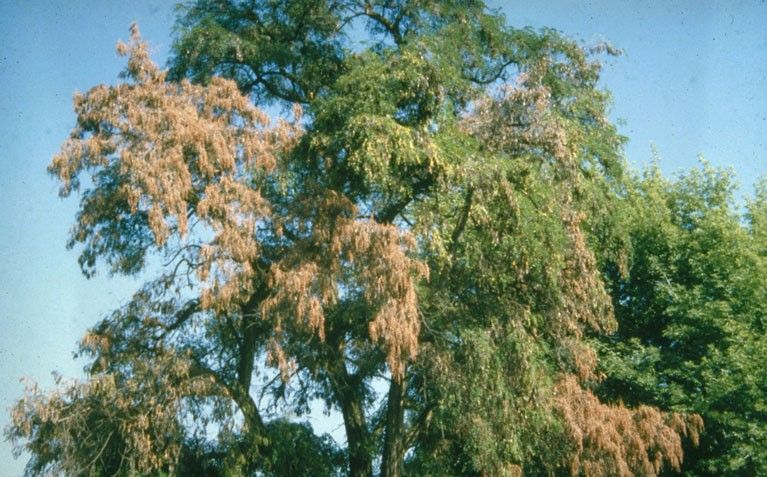
Arbor-wellness: Verticillium Wilt
We are seeing more trees this summer that look green and healthy one week and within a few weeks entire branches turn brown and leaves dry up, the most common cause of this problem is verticillium wilt. Verticillium is a soil borne root disease that usually infects through the root as they contact verticillium spores in the soil.
Many trees are susceptible to verticillium including, arborvitae, birch, crabapple, ginkgo, maple, oak, pine, spruce and tulip trees. What makes this disease so difficult is that by the time we typically see damage, the disease has spread too far and tree removal is usually the only option. Once a soil is infected it is very difficult to kill the spores, so it usually remains in the soil indefinitely. However, there are some ways to protect your trees and reduce the chance of infection.
My tree was looked good last week and now this week it has several branches with dead leaves, what’s wrong?
This is most likely verticillium wilt, which is caused by a soil fungus that can lie dormant in the soil for many years. When the roots of susceptible plants grow close to the spores, the fungus germinates and infects the roots of the plants through wounds or natural openings. The fungus spreads into the branches through the plant’s vascular system and at the same time, causes the plant cells to “plug” themselves. Once this happens, water can no longer reach the leaves and they wilt and die, often all along one or branches at a time. It often happens quite suddenly, although in some plants the leaves turn yellow or brown first.
Why is this so prevalent now?
That is a hard question to answer but yes, we are seeing more of this disease this summer and fall. Essentially, our trees are still recovering from the drought of several years back. Their root systems were compromised. The moisture this spring really encouraged new rooting and also encouraged more root diseases overall.
How can I be sure my tree has this disease?
On certain trees – maples and tulip trees in particular, elongated dead areas of bark, called cankers, may appear on diseased branches or trunks. On most trees with the disease, the sapwood of smaller branches is streaked brown or black, occasionally in other colors too. However, since not every tree exhibits this discoloration, testing tissue in a lab may be recommended to confirm the diagnosis.
Will my tree survive?
Unfortunately, usually not. There seem to be two forms of the disease, one in which plants die slowly over several years and another where they die rapidly within a few weeks. Trees that show minor branch wilt one year may show more the next year or may not show symptoms again for several years.
Is there anything I can do for the other trees on my property?
There are ways to help protect your trees, particularly if they don’t show signs of the disease. First make sure the tree is not stressed – proper water and proper feeding are important here. Secondly, there are some good guy fungal species that do battle against this root disease and several others, too. The good guys inoculate onto the roots of a tree and fight and kill these fungal pathogens. (I like to use the analogy of probiotics that help our digestive system stay healthy.) But this process should start before verticillium wilt becomes established in the tree.
Our arborists at Arborwell can recommend a protective program for the trees that are susceptible on your site. Fill out the form below to get in contact with an arborist today!
preventative tree care, Prevention, root disease, tree care, verticillium wilt